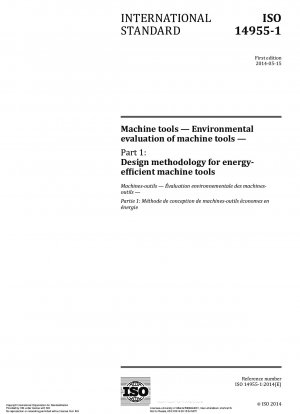ISO 14955-1:2014
Machine tools - Environmental evaluation of machine tools - Part 1: Design methodology for energy-efficient machine tools
- Standard No.
- ISO 14955-1:2014
- Release Date
- 2014
- Published By
- International Organization for Standardization (ISO)
- Status
- Replace By
- ISO 14955-1:2017
- Latest
- ISO 14955-1:2017
- Scope
- This part of ISO 14955 constitutes the application of eco-design standards to machine tools, mainly for metal working numerically controlled (NC) machine tools. This part of ISO 14955 addresses the energy efficiency of machine tools during the use stage, i.e. the working life of the machine tool. Environmental relevant stages other than the use stage and relative impacts other than energy supplied to machine tools are not within the scope of this part of ISO 14955 and need a special treatment (e.g. according to ISO/TR 14062). Elements of eco-design procedure according to ISO/TR 14062 are applied to machine tools. Reporting of results to users and suppliers and monitoring of results are defined. Evaluation of energy efficiency implies quantification of the resources used, i.e. energy supplied, and of the result achieved. This part of ISO 14955 provides guidance for a reproducible quantification of the energy supplied. It does not suggest a methodology for quantifying the result achieved due to the lack of universal criteria. The result achieved in industrial application being machined workpieces, their properties (e.g. material, shape, accuracy, surface quality), the constraints of production (e.g. minimum lot size, flexibility), and other appropriate parameters for the quantification of the result achieved are intended to be determined specifically for each application or for a set of applications. This part of ISO 14955 defines methods for setting up a process for integrating energy-efficiency aspects into machine tool design. It does not support the comparison of machine tools. Also, this part of ISO 14955 does not deal with the effect of different user behaviours or different manufacturing strategies during the use phase. Lists of environmentally relevant improvements and machine components, control of machine components, and combinations of machine components are given in two informative annexes, one for metal-cutting machine tools (Annex A) and one for metal-forming machine tools (Annex B). Annex C provides an example of application of the methodology. Other machine tools, e.g. laser-cutting machine tools, material additive machine tools, and woodworking machine tools are currently not covered by informative annexes. NOTE Certain machining processes and specific machine tools can allow significant changes in the environmental impact of machined workpieces, e.g. material reduction for aluminium cans by application of special press technology, higher performance of compressors by machining on precision form grinders.[3][5] The environmental impact of such processes or machine tools might be less important compared to the environmental impact of the machined workpieces and their application. These changes in the environmental impact of machined workpieces are not subject of this part of ISO 14955 but might be important if different machining processes or different machine tools have to be compared related to environmental impact of products. For instance, the accuracy of a machined workpiece might be a significant parameter for the environmental impact of the workpiece in its use stage, and any attempt to compare machine tools is intended to take this into account necessarily.
ISO 14955-1:2014 Referenced Document
- ISO 11011:2013 Compressed air.Energy efficiency.Assessment
- ISO 1328:1975 Parallel involute gears; ISO system of accuracy
- ISO 14021:1999 Environmental labels and declarations - Self-declared environmental claims (Type II environmental labelling)
- ISO 14031:2013 Environmental management .Environmental performance evaluation.Guidelines
- ISO 14040:2006 Environmental management - Life cycle assessment - Principles and framework
- ISO 4413:2010 Hydraulic fluid power - General rules and safety requirements for systems and their components
- ISO 4414:2010 Pneumatic fluid power - General rules and safety requirements for systems and their components
- ISO 50001:2011 Energy management systems - Requirements with guidance for use
- ISO/TR 14062:2002 Environmental management - Integrating environmental aspects into product design and development
ISO 14955-1:2014 history
- 2017 ISO 14955-1:2017 Machine tools - Environmental evaluation of machine tools - Part 1: Design methodology for energy-efficient machine tools
- 2014 ISO 14955-1:2014 Machine tools - Environmental evaluation of machine tools - Part 1: Design methodology for energy-efficient machine tools
